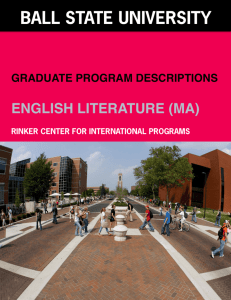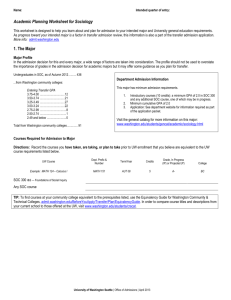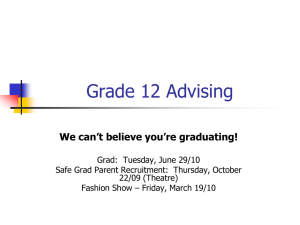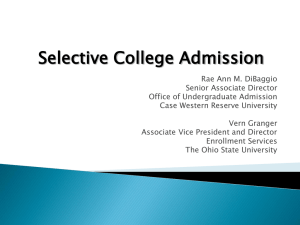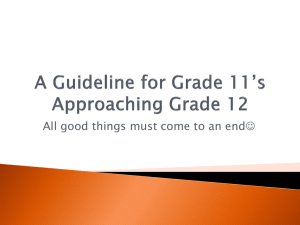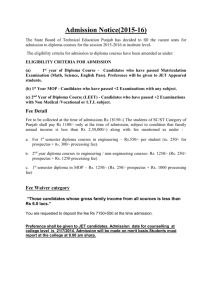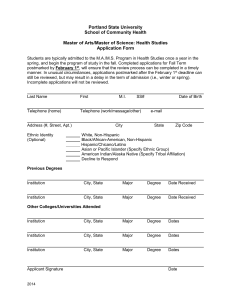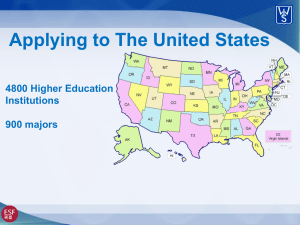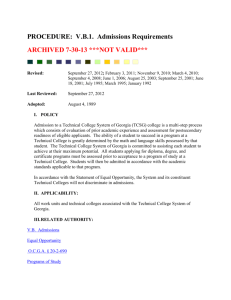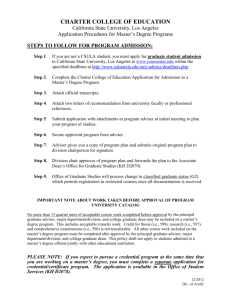PPT Slides - OISE - University of Toronto
advertisement
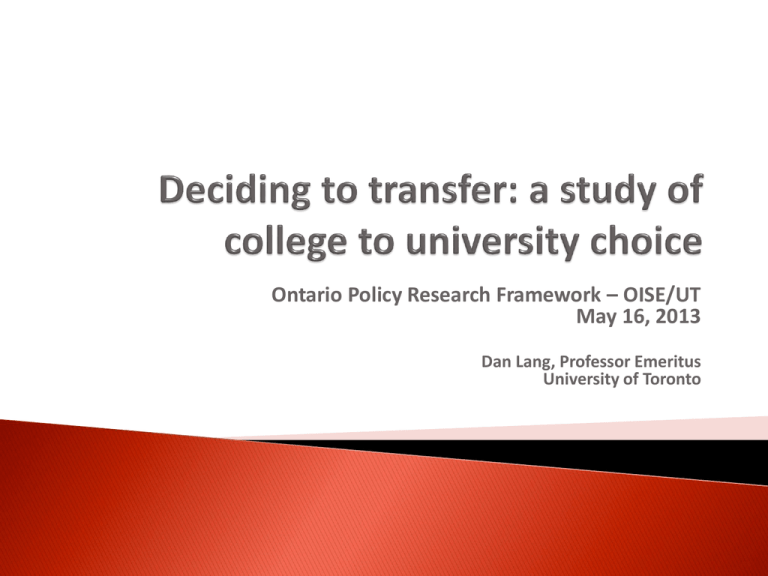
Ontario Policy Research Framework – OISE/UT May 16, 2013 Dan Lang, Professor Emeritus University of Toronto Population: students entering college for the first time Question: Why, when and how plans were formed and decisions made about transferring to a baccalaureate program? Objective: To determine at what point transfer as a coincidental behaviour became a planned behaviour and for what reasons Five Ontario colleges of different types participated in the study. Starting from the Institutional Taxonomy developed by Floyd, Skolnik and Walker: - Concurrent campus - University Centre - Traditional college - College in a location with no nearby university, but with articulation elsewhere - College with a nearby university but with no articulation General arts and science programs with significant enrolment Exit points after one, two and three years Two colleges offered internal transfer to baccalaureate degrees One of the questions on the college surveys of entering students asked whether students were interested in transfer. All Students who said yes were invited to information sessions . Sessions were held at each College. At the end of information sessions students were invited to participate in the study. 675 Students participated in the study The students were split into 2 groups those who were still interested in transfer (288) and those who were no longer interested in transfer (387). Both groups completed identical surveys Students who were still interested in transfer were also invited to participate in continuation of the study: interviews, access to academic records, and “tracking” beginning in 2008-2009. 224 students consented to participate 55 students failed to re-register, had their registration withdrawn, transferred, graduated or withdrew from the study Of the remaining 169, 123 were interviewed and tracked into 2nd and in some cases 3rd year For the participants in this study – Transfer means “moving” from one institution to another regardless of type It does NOT mean “moving” from a diploma to a degree At three different points in the interview students were asked about the value, quality and reputation of five types of post-secondary arrangements: College University Polytechnic institute University college (for example, Durham College/UOIT) Institute of Technology and Advanced Learning (for example Humber College) University partnership centre (for example, Georgian College) Fewer that four % of all respondents recognized the name ITAL, even those at colleges that were ITALs. After the final interview – participants were classified as weak, average or strong (based on final grades in Grade 12 and college GPA) One of the questions asked during the semi-structured interview was: In terms of academic difficulty - was college harder or easier than what expected? A trend emerged: weak at entry college harder became less interested in transfer strong at entry college easier stayed interested in transfer average students what they expected or easier stayed interested in transfer Finding: Attending college as a “second chance” to qualify for University is not a viable option for below average students Two participating colleges had large numbers of students whose: First language was not English Had not passed TOEFAL exams or had not studied in an English-speaking college or university long enough to be exempt from the university level English language requirements Not interested in transfer per se Finding: These students were interested solely in spending enough time in an English speaking college to be exempt from university foreign level language admission requirements. No interest in credit transfer. Indifferent to college program. The “Concurrent campus” college 20% higher rate of transfer than the average rate for all five participating colleges: college also had six university partners offering courses on campus Over 90% of students who transferred from this college transferred to the university nearest to the college, and in two programs. Finding: With one possible exception – type of college did NOT affect transfer In year prior to commencement of study provincial government introduced a program of general financial assistance for re-training of students who had lost jobs: At 3 colleges – these students made up significant subset of the participants All had above average GPA’s Interest in transfer remained strong Exemplified transfer as a coincidental behaviour; students had not expected to lose jobs and had no prior interest in college or transfer. Interest motivated by the government program Choice of program motivated by counseling required prior to application for admission to the government program Literature and practice presumes a pull vs. push pattern: students will turn to sources designed to draw or “pull” them to transfer to university Choice options in survey and in interviews reflected this, for example guidance counselors, central provincial website. College Web- site not included in choice, but was single most utilized source Finding: While one should be cautious about over-generalization, it may be that as many students are “pushed” towards transfer as are “pulled” toward it . Counseling plays a larger role than recruitment At least six different actual “scenarios”. 1. Enter college and transfer to university as soon as possible, regardless of number of credits transferred or of not earning a college credential. 2. Enter college, graduate with diploma, and qualify for admission to university to a program unrelated to their college credential. For these students the primary objective was admission. The number of credits transferred was unimportant or irrelevant. 3. Enter college, graduate with a diploma, and qualify for admission to university in a program related to their college credential. For these students the primary objective was admission. The transferability of credits was important but not important enough to affect their university decision. 4 Enter college, graduate with a diploma, and qualify for admission to university in a program related to their college credential. For these students the admission and transferability of credits were dual and approximately equal objectives. Transferability of credits was important enough to affect their university decision. 5. Enter a two-year college program, elect an optional third year, graduate with no immediate plans to transfer. 6 Enter college, transfer internally to another college diploma program, graduate with no immediate plans to transfer. Email: dan.lang@utoronto.ca valerie.lopes@senecacollege.ca
